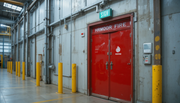UK Fire Door Regulations: A Comprehensive Guide to Compliance and Safety
Fire doors are critical safety features designed to prevent the spread of fire and smoke, protect escape routes, and ultimately save lives. In the UK, strict regulations govern the installation, maintenance, and inspection of fire doors, particularly in multi-occupied residential buildings. Understanding these regulations is essential for property owners, managing agents, and anyone designated as the "Responsible Person" under the law.This guide provides an updated overview of UK fire door regulations, inspection requirements, potential penalties for non-compliance, and answers to common questions about fire door safety.
Key Fire Door Regulations in the UK
The primary legislation governing fire door compliance includes:
Regulatory Reform (Fire Safety) Order 2005
This foundational legislation requires the "Responsible Person" to ensure that fire safety measures—including fire doors—are in place, maintained, and effective in all non-domestic premises and common parts of residential buildings.
Fire Safety (England) Regulations 2022
Introduced in response to the Grenfell Tower tragedy, these regulations impose stricter requirements on multi-occupied residential buildings over 11 meters in height. They specify mandatory fire door checks to enhance safety in high-rise dwellings.
Who Is the "Responsible Person"?
The "Responsible Person" is typically the property owner, landlord, building manager, or managing agent. This individual holds legal responsibility for ensuring the building complies with all fire safety regulations, including:
- Conducting regular fire risk assessments.
- Ensuring fire doors meet safety standards.
- Maintaining records of inspections and maintenance.
- Taking corrective action if issues are identified.
Failure to fulfill these duties can result in legal action, including fines and potential liability in the event of a fire.
Fire Door Inspection Requirements
1. Regular Inspections Based on Building Type and Usage
For multi-occupied residential buildings over 11 meters in height, the Fire Safety (England) Regulations 2022 require:
- Communal Area Fire Doors – Inspected quarterly (every 3 months) to ensure they are functioning correctly and free from damage.
- Flat Entrance Fire Doors – Inspected annually to maintain their fire resistance and proper functionality.
2. Key Checks During Fire Door Inspections
- Door Functionality:Ensure the door fully closes without obstruction.Check the self-closing mechanism for proper operation.Verify there are no excessive gaps between the door and the frame (typically no more than 3-4mm).
- Ensure the door fully closes without obstruction.
- Check the self-closing mechanism for proper operation.
- Verify there are no excessive gaps between the door and the frame (typically no more than 3-4mm).
- Intumescent Seals:Inspect the heat-expanding seals for any signs of damage, gaps, or degradation.These seals help block smoke and fire spread when exposed to high temperatures.
- Inspect the heat-expanding seals for any signs of damage, gaps, or degradation.
- These seals help block smoke and fire spread when exposed to high temperatures.
- Hinges and Fixings:Confirm that hinges are tightly fastened, undamaged, and free of corrosion.Check for missing screws or worn parts that could hinder the door's operation.
- Confirm that hinges are tightly fastened, undamaged, and free of corrosion.
- Check for missing screws or worn parts that could hinder the door's operation.
- Door Integrity:Look for cracks, warping, or damage to the fire door leaf that could compromise its integrity.Ensure any glazing (if present) meets fire safety standards.
- Look for cracks, warping, or damage to the fire door leaf that could compromise its integrity.
- Ensure any glazing (if present) meets fire safety standards.
Fire Door Standards to Follow
Fire doors in the UK must comply with British Standard BS 8214:2016, which sets out specifications for timber-based fire doors. The most common fire resistance ratings include:
- FD30: 30 minutes of fire protection.
- FD60: 60 minutes of fire protection.
All fire doors should display clear certification labels and markings to confirm compliance with these standards.The Importance of Fire Risk AssessmentsFire door safety is a critical component of a broader Fire Risk Assessment (FRA), which is a legal requirement for all non-domestic premises and common areas of residential buildings.Key elements of a Fire Risk Assessment related to fire doors include:
- Identifying fire hazards and vulnerable areas.
- Evaluating the condition and effectiveness of all fire doors.
- Outlining necessary actions to improve fire safety.
- Implementing regular review dates to ensure ongoing compliance.
Consequences of Non-Compliance
Failure to comply with UK fire door regulations can have serious legal and financial repercussions:Fines and Penalties: Local fire authorities can issue enforcement notices or hefty fines for non-compliance. In severe cases, criminal prosecution may occur.Liability in Fire Incidents: If a fire results in injury or death due to non-compliant fire doors, the "Responsible Person" may face legal liability and compensation claims.Insurance Complications: Non-compliant fire safety measures can void insurance policies, leading to further financial risk in the event of damage or loss.Best Practices for Fire Door Compliance
- Hire Qualified Inspectors: Engage certified fire door inspectors to conduct thorough inspections and issue compliance reports.
- Maintain Accurate Records: Keep detailed documentation of all fire door checks, maintenance, and corrective actions. This can be critical in legal disputes or audits.
- Train Building Staff and Residents: Ensure all staff and residents understand the importance of fire doors and how to report faults. Discourage practices that compromise fire door safety, such as propping doors open.
Frequently Asked Questions (FAQs) About UK Fire Door Regulations
How often do fire doors need to be inspected?
A: For multi-occupied residential buildings over 11 meters:
- Communal fire doors – Every 3 months.
- Flat entrance doors – Annually. Other buildings should conduct inspections in line with their fire risk assessments.
What are intumescent seals, and why are they important?
A: Intumescent seals are heat-activated strips fitted around fire doors. When exposed to heat, they expand to seal gaps around the door, preventing smoke and fire from spreading.
Can anyone inspect fire doors, or does it need to be a certified professional?
A: While basic checks can be performed by trained staff, in-depth inspections—especially for multi-occupied or high-rise buildings—should be carried out by qualified fire door inspectors to ensure compliance.
What happens if my building fails a fire door inspection?
A: Immediate corrective actions must be taken to address any issues. Failing to fix non-compliant fire doors can lead to enforcement notices, fines, or legal action.
Are there specific fire door requirements for commercial buildings?
A: Yes. While the Fire Safety (England) Regulations 2022 focus on residential buildings over 11 meters, commercial properties must still comply with the Regulatory Reform (Fire Safety) Order 2005, requiring regular fire risk assessments and proper fire door maintenance.
What documentation should I keep for fire door compliance?
A: Maintain a comprehensive log that includes:
- Inspection reports and maintenance records.
- Certification for fire door installations.
- Details of repairs or upgrades.
- Fire Risk Assessment reports.
Conclusion
Fire doors are essential for protecting lives and property in the event of a fire. By adhering to UK fire door regulations, conducting regular inspections, and maintaining proper records, property owners and managers can ensure compliance, reduce liability, and enhance overall building safety.If you’re unsure about your building’s fire door compliance or need a professional inspection, consult a certified fire safety professional to help you meet legal obligations and maintain peace of mind.



